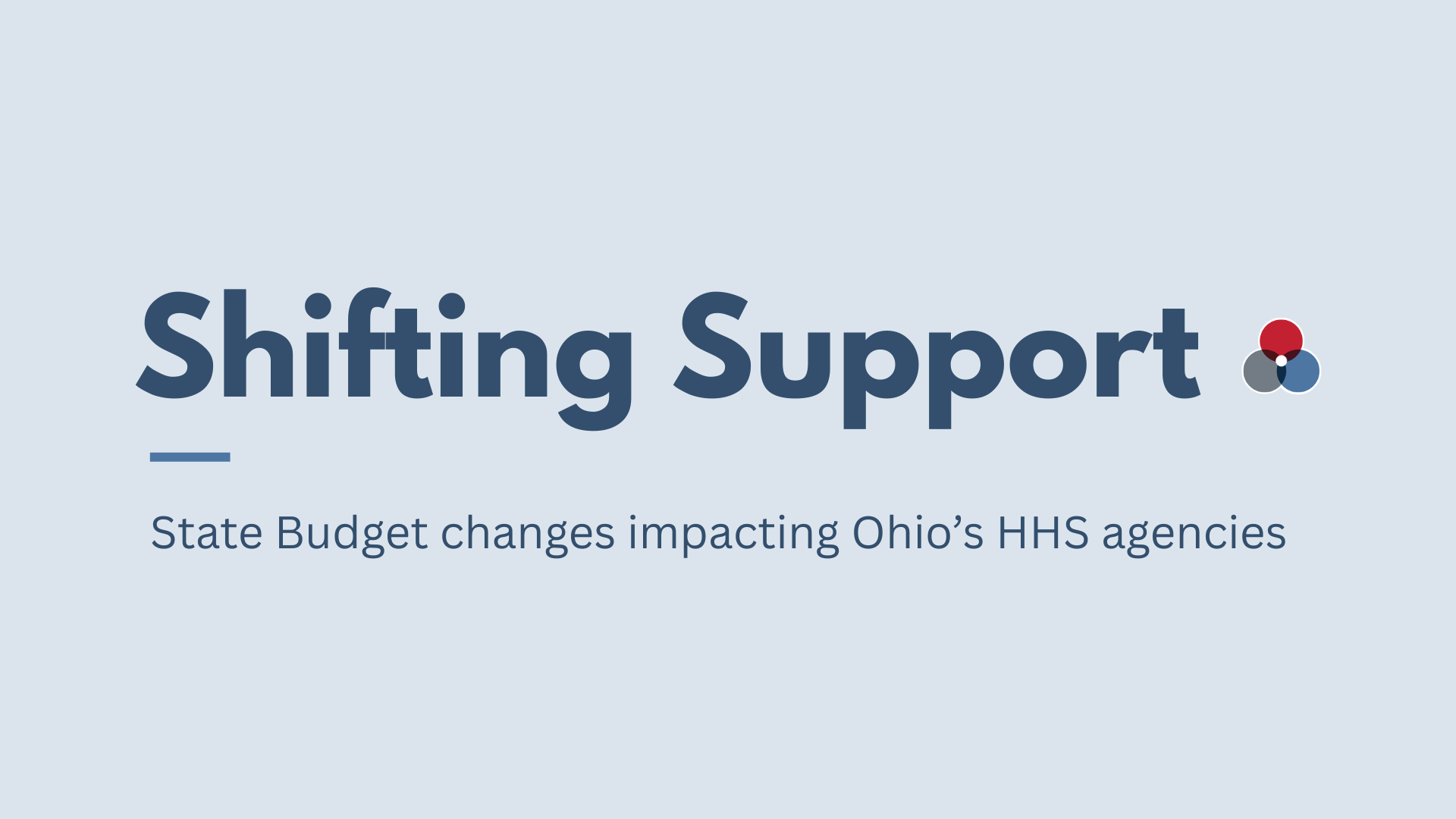By Loren Anthes, Senior Fellow/William C. and Elizabeth M. Treuhaft Chair for Health PlanningNatasha Takyi-Micah, Public Policy and External Affairs AssociateIntroductionWith the global pandemic, Medicaid’s role as a first responder in public health was on full display. After many months of declining enrollment in the program and a renewed focus on increasing value through managed care, the policy environment regarding Medicaid is being significantly reoriented. With the declaration of the public health emergency, and the resultant relief legislation developed by Congress, Ohio was able to enact a number of reforms to quickly accommodate the needs of beneficiaries and the economic realities of Ohio’s newfound recession. Beyond this, most of the policy action in the legislative budget process was focused on institutional long-term care, with significant allocations for nursing facilities as they sought to rebase their foundational rates.
Key Takeaways
- Medicaid has continued its role as a critical safety net, providing coverage to millions of Ohioans during the pandemic and ensuring Ohio’s budget remains whole as we continue to recover
- Changes in Medicaid spending may encourage nursing facilities to improve quality of life for residents and increase living wages for staff
- Most of the programmatic reforms in Medicaid are tied to the state’s efforts to reprocure managed care, though that effort has faced threats from legacy plans seeking to diminish competition
Financial Picture & Caseload
In regard to beneficiaries, several things happened. First, Ohio’s normal eligibility determination process was suspended. As the economy retracted and Ohioans lost their employer-sponsored insurance, Medicaid ensured coverage during a critical time. Also, given Ohio’s track record of relying on in-person county case management to process eligibility applications, suspending the normal process of coverage ensured county caseworkers were also safe, preventing county offices from being potential sites of COVID-19 spread.

While initial estimates projected Ohio’s enrollment to be a potential increase of over one million new enrollees into the program, the enrollment was half that, with 476,555 Ohioans enrolling between February, 2020, and August, 2021, an increase of 17 percent.[1] Importantly, half of this caseload increase came from the Group VIII and Covered Families & Children (CFC) categories (14 and 36 percent, respectively), suggesting the majority of the benefit went to working Ohioans, parents and children. With this significant variance, however, projections associated with spending in the program were hard to predict and the Department is only recently able to better match its forecast to the experience.[2]
Because expansion already has a federal matching rate of 90 percent, the increased federal resources ensured Ohio Medicaid did not have to make cuts to other populations in the program.
As a counter-cyclical program, recessionary periods typically mean more spending with less money available in Ohio Medicaid. This is due to the fact that economic retractions often lead to people losing their employer-sponsored insurance and, as a result, enrolling at a time where tax collections are down. Fortunately, Congress increased the federal share for most populations, enabling the state to forego hundreds of millions in direct spending to cover the increased caseloads. This additional match, worth about $100 million per month, enabled the state to prevent cuts elsewhere by freeing up state resources to cover reduced collections used to pay for education, corrections and other basic services. This direct benefit, however, is primarily accrued to parents, children and persons with disabilities.Because expansion already has a federal matching rate of 90 percent, the increased federal resources ensured Ohio Medicaid did not have to make cuts to other populations in the program. Especially as the pandemic had a pronounced impact on high-risk individuals in nursing facilities and other medically complex populations, this enhanced funding ensured Ohio’s coverage landscape remained stable.
This most recent budget, though, is still beset by the complexities and challenges of the pandemic and its remaining unknowns.
This most recent budget, though, is still beset by the complexities and challenges of the pandemic and its remaining unknowns. From just fiscal year 2020 (FY20) to FY21, the total program expenditure increased by over $3 billion, mainly due to the increased enrollment. The state share actually went down as a percentage of total spending, however, because of increased federal match from the relief legislation. As the state budget outlines, in FY22, this downward trend continues but swiftly changes in FY23 as the responsibility for the match goes back to the state. In the end, the program expenditures will increase to over $32 billion, an increase of $7 billion compared to FY20.Looking more deeply into the numbers reveals more insights about this overall increase. First of all, the majority of the programmatic changes that increased Medicaid’s budget were created by the General Assembly and are primarily tied to increased funding for nursing facilities. Analysis on those changes will be covered in subsequent sections of this brief. What’s more, out of this total sum, $1.2 billion is set aside in the Health and Human Services Fund (ALI 651689) to offset General Revenue spending and is comprised of federal funds. To explain, these dollars are associated with the additional federal match that came to Ohio and, as a way to accommodate the shift from federal to state financing at the termination of the public health emergency, will be used to accommodate the downward pressure that switch will entail on state resources. That is, of course, assuming the Public Health Emergency isn’t extended, thereby extending the federal match. What’s more, depending on the state’s strategy for reigniting its eligibility system, there may be significant caseload changes that could build on the uncertainty experienced during the first months of the pandemic.
Long-Term Care Initiatives
With the passage of the state budget, the Ohio Department of Medicaid (ODM) received funds for long-term care initiatives primarily focused on institutions. One of the initiatives includes the continuation of nursing facility quality payments. The state will allocate $170 million ($56 million state share) in FY22 and $170 million ($61 million state share) in FY23 to “reestablish a quality incentive payment to eligible nursing facilities as part of their Medicaid payments.” [3] This payment will vary based on the quality score— the total number of points under the Five-Star Quality Rating System from the Centers for Medicare and Medicaid Services (CMS)— for each nursing home. To that end, there will be funds for the increased quality incentive payment: $25 million ($8.2 million state share) in FY22 and $125 million ($44.9 million state share) in FY23. This initiative could encourage nursing homes to enhance their programs and facilities in order to help older adults and improve their living conditions.
The state will allocate $170 million in FY22 and $170 million in FY23 to “reestablish a quality incentive payment to eligible nursing facilities as part of their Medicaid payments.”
Another initiative that ODM will engage in is nursing facility rebasing. LeadingAge Ohio defined rebasing as “a safety net for providers that ensures that Medicaid payment does not lag too far behind the costs of care.” [4] Previously, Ohio nursing homes were paid according to 2014 costs of care, but now they will be paid according to 2019 costs. 5 The state will give $125 million each fiscal year. Likewise, the state share will be $41.2 million in FY22 and $44.9 million in FY23.This payment for nursing facilities will be divided depending on a rebasing calculation which includes direct care costs, ancillary and support costs and tax costs. Because nursing home staff are categorized as a direct care cost, they will likely receive an increase in their pay. As we have documented previously, Ohio has historically underpaid it’s institutional workforce, leading to issues with disparities, high turnover rates and poorer quality. Professional development is a category under direct care costs, however, it is unknown whether money will be assigned to it or for what purpose. If nursing homes are able to allocate some money for professional development, we recommend there should be trainings that address implicit bias and care for older adults since Ohio nursing home residents face many disparities and negative health outcomes.A key initiative of ODM that impacts older adults is assisted living. The state will increase Medicaid reimbursement rates for assisted living by 6 percent over the next two fiscal years. 6 This is good news for assisted living providers because there has not been an increase in funds for the past 10 years. 7 With this initiative, older adults in assisted living will receive better services for their well-being.
Managed Care
In perhaps the most significant shift in the basic policy construction of the state’s program, Ohio moved forward with the procurement of new managed care plans. This procurement not only included the contracts for the general benefit administration of the program, but also the creation of a fiscal intermediary, a single pharmacy benefit manager and a new insurance plan for medically complex children called OhioRISE (Resilience through Integrated Systems and Excellence). In total, these reforms saved Ohio Medicaid over $416 million through the simplification and reduction of duplicative services by the plans.[3]Despite these savings, the effort to reprocure Ohio’s managed care system faced significant scrutiny by a few members of the General Assembly.[4] In a last-minute effort by one of the losing bidders, language was inserted into the budget that would have mandated the Ohio Department of Medicaid terminate its current procurement and restart the process. We have previously written about the impacts of this maneuver, including the loss of the savings produced, the increased burden on providers to bill and contract with insurers and, notably, the functional end of OhioRISE, the program designed to end the custody relinquishment of medically complex children to the state. In the end, however, the governor vetoed the language that would have compromised the state’s efforts and now Ohio is set to launch the totality of the programs by summer 2022.
Policymakers and advocates would be wise to look beyond who is enrolled and, instead, look more deeply into the sources of spending.
Conclusion
While the pandemic is ongoing and its effects are still being felt, policymakers are already contemplating what a return to normalcy will look like. In the context of the General Assembly and Medicaid, this means a renewed focus on redetermining eligibility for the program, which is arguably the most important policy condition related to spending and cost at the termination of the Public Health Emergency. However, policymakers and advocates would be wise to look beyond who is enrolled and, instead, look more deeply into the sources of spending.First, and most obviously, is the endemic poverty and fragile economic conditions of large swaths of Ohioans. Medicaid is driven by your income, primarily, and if you are not impoverished, you are not eligible. Second, it is worthwhile to build on making the program more efficient, ensuring that the value we are seeking is found in the health outcomes of the populations that rely on the coverage. While economic impact is an important lens to understand the role of Medicaid, it is perplexing that there was a policy push to ensure an insurance contractor was given an award instead of supporting a more competitive system built on rewarding quality. And, finally, Ohio needs to wrangle its spending in institutional settings. We have a history of underperformance in institutions, and the reimbursement is finally shifting towards strategies we know can create a healthier environment for Ohio’s older adults and persons with disabilities.Sources:[1] “COVID-19 Impact on Medicaid, Marketplace, and the Uninsured, by State.” Health Management Associates, April 3, 2020. https://www.healthmanagement.com/wp-content/uploads/HMA-Estimates-of-COVID-Impact-on-Coverage-public-version-for-April-3-830-CT.pdf.[2] Expenditure Report to JMOC. (2021, June). Retrieved October 1, 2021, from https://www.jmoc.state.oh.us/assets/meetings/Expenditure%20Report%20of%20ODM%20-%2020210616.pdf.[3] Ohio Legislative Service Commission. (2021, August). Greenbook LBO Analysis of Enacted Budget: Ohio Department of Medicaid. https://www.lsc.ohio.gov/documents/budget/134/MainOperating/greenbook/MCD.PDF[4] LeadingAge Ohio. (n.d.). FY2022-2023 State Budget Issue Brief: Skilled nursing facilities. https://leadingageohio.org/aws/LAO/asset_manager/get_file/552371?ver=1#:~:text=Rebasing%20is%20a%20safety%20net,catch%20up%E2%80%9D%20to%202019%20cost[5] Wu, T. (2021, July 12). Every five years, Ohio nursing homes get new Medicaid reimbursement rates. Amid COVID-19, it's even more critical. The Columbus Dispatch. https://www.dispatch.com/story/news/healthcare/2021/07/12/ohio-nursing-homes-get-new-rebasing-based-2019-data-medicaid-reimbursement-dewine-staffing-shortages/7891153002/[6] Area Agency on Agency. (2021, August 5). Increase in funding for senior services in Ohio. https://info4seniors.org/increase-in-funding-for-senior-services-in-ohio/[7] Wu, T. (2021, September 29). Historically underfunded, home and community-based care in Ohio finally will get $517 million boost. The Columbus Dispatch. https://www.dispatch.com/story/news/healthcare/2021/09/30/home-care-ohio-see-fmap-arpa-medicaid-reimbursement-hcbs-waivers-disability-covid-19/5833726001/[8] SFY 2022-2023 ODM Next Gen Procurement Fiscal Impact. (2021, June). Retrieved October 1, 2021, from https://medicaid.ohio.gov/wps/portal/gov/medicaid/about-us/budget/2022-2023-budget/sfy-2022-2023-odm-next-gen-procurement-fiscal-impact.[9] The Statehouse News Bureau | By Karen Kasler. (2021, June 25). Ohio GOP Senate change to budget could endanger program for at-risk youth. The Statehouse News Bureau. Retrieved October 1, 2021, from https://www.statenews.org/government-politics/2021-06-24/ohio-gop-senate-change-to-budget-could-endanger-program-for-at-risk-youth.










